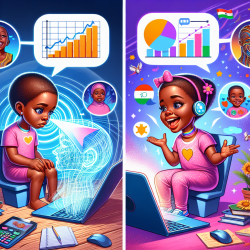The Impact of Data-Driven Speech Therapy on Child Development
As a PhD graduate in speech-language pathology, I am deeply committed to leveraging data-driven decisions to create exceptional outcomes for children. At TinyEYE, we provide online therapy services to schools, ensuring that every child has access to the support they need to thrive. In this blog, we will explore the profound impact that data-driven speech therapy can have on child development and educational outcomes.
Understanding Data-Driven Speech Therapy
Data-driven speech therapy involves the systematic collection and analysis of data to inform therapeutic decisions. This approach allows speech-language pathologists (SLPs) to tailor interventions to the specific needs of each child, monitor progress over time, and make evidence-based adjustments to therapy plans.
The Benefits of Data-Driven Decisions
Using data to guide speech therapy offers numerous advantages:
- Personalized Interventions: Data allows SLPs to identify each child's unique strengths and areas of need, enabling the development of customized therapy plans.
- Objective Progress Monitoring: Regular data collection provides objective measures of a child's progress, ensuring that interventions are effective and goals are being met.
- Informed Adjustments: Data-driven insights enable SLPs to make timely adjustments to therapy plans, ensuring that children receive the most effective support.
- Enhanced Communication: Data can be shared with parents, teachers, and other stakeholders, fostering a collaborative approach to a child's development.
How TinyEYE Utilizes Data-Driven Speech Therapy
At TinyEYE, we harness the power of data to enhance our online therapy services. Our platform is designed to collect and analyze data seamlessly, providing SLPs with real-time insights into each child's progress. Here’s how we do it:
- Initial Assessments: Comprehensive assessments are conducted to establish a baseline for each child's speech and language skills.
- Regular Monitoring: Data is collected during each therapy session to track progress and identify trends.
- Custom Reports: Detailed reports are generated to provide a clear picture of a child's development, which can be shared with parents and educators.
- Ongoing Adjustments: Therapy plans are continuously adjusted based on data insights to ensure optimal outcomes.
Case Study: Success Through Data-Driven Therapy
Consider the case of Emily, a 7-year-old student who struggled with articulation and expressive language. Through our data-driven approach, we were able to create a customized therapy plan that addressed her specific needs. By regularly monitoring her progress and making informed adjustments, Emily showed significant improvement in her speech and language skills within six months. Her teachers and parents reported noticeable changes in her confidence and academic performance.
The Future of Speech Therapy
The integration of data-driven decisions in speech therapy represents a significant advancement in the field. As technology continues to evolve, the potential for even more precise and effective interventions grows. At TinyEYE, we are committed to staying at the forefront of these developments, ensuring that every child receives the highest quality of care.
Conclusion
Data-driven speech therapy is not just a trend; it is a transformative approach that has the power to significantly enhance child development and educational outcomes. By leveraging data, SLPs can provide personalized, effective, and collaborative support to children, helping them reach their full potential. At TinyEYE, we are proud to be leaders in this field, and we are dedicated to making a positive impact on the lives of children through our innovative online therapy services.










